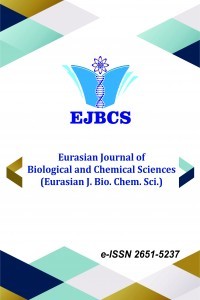SARS-COV-2 enfeksiyonu olan hastalarda laboratuvar parametrelerin prognoz değeri
SARS-CoV-2, Koronavirüs, COVID-19, Laboratuvar parametreleri, Prognoz
Prognostic value of laboratory parameters in patients with SARS-COV-2 infection
SARS-CoV-2, Coronavirus, COVID-19, Laboratory parameters, Prognosis,
___
- Abbasi-Oshaghi E, Mirzaei F, Farahani F, Khodadadi I, Tayebini H. 2020. Diagnosis and treatment of coronavirus disease 2019 (COVID-19): Laboratory, PCR, and chest CT imaging findings. International Journal of Surgery, 79: 143-153.
- Bashash D, Abolghasemi H, Salari S, Olfatifar M, Eshghi P, Akbari ME. 2020. Elevation of D-Dimer, But Not PT and aPTT, Reflects the Progression of COVID-19 Toward an Unfavorable Outcome: A Meta-Analysis. IJBC., 12(2):47-53.
- Benvenuto D, Giovanetti M, Ciccozzi A, Spoto S, Angeletti S, Ciccozzi M. 2020. The 2019-new coronavirus epidemic: evidence for virus evolution, J. Med. Virol., 92(4): 455-459.
- Dasgupta A, Sepulveda JL. 2013. Accurate Results in the Clinical Laboratory A Guide to Error Detection and Correction. In: Sepulveda JL, eds. Chapter 1 - Variation, Errors, and Quality in the Clinical Laboratory. ISBN: 978-0-12-415783-5. Elsevier, 1-8.
- Goudouris ES. 2021. Laboratory diagnosis of COVID-19. J Pediatr (Rio J), 97:7-12.
- Hu R, Hanc C, Pei S, Yin M, Chen X. 2020. Procalcitonin levels in COVID-19 patients. International Journal of Antimicrobial Agents, 56(2): 106051
- Huang C, Wang Y, Li X, Ren L, Zhao J, Hu Y, Zhang L, Fan G, Xu J, Gu X. 2020. Clinical features of patients infected with 2019 novel coronavirus in Wuhan, China. The Lancet, 395(10223):497-506.
- Kernan KF, Carcillo JA. 2017. Hyperferritinemia and inflammation. Int. Immunol., 29(9): 401-409.
- Lagunas-Rangel FA. 2020. Neutrophil-to-lymphocyte ratio and lymphocyte-to-C-reactive protein ratio in patients with severe coronavirus disease 2019 (COVID-19): A meta-analysis. J. Med. Virol., 92(10):1733-1734.
- Liu J, Liu Y, Xiang P, Pu L, Xiong H, Li C, Zhang M, Tan J, Xu Y, Song R. 2019. Neutrophil-to-lymphocyte ratio predicts critical illness patients with 2019 coronavirus disease in the early stage. J. Transl. Med., 18(2020):1-12.
- Liu Y, Du J, Chen J, Jin Y, Peng L, Wang HHX, Luo M, Chen L, Zhao Y. 2020. Neutrophil-to-lymphocyte ratio as an independent risk factor for mortality in hospitalized patients with COVID-19. Journal of Infection, 81(1) e6-e12.
- Lu H, Stratton CV, Tang YW. The Wuhan SARS-CoV-2–What's Next for China, J. Med. Virol. 92(6):546-547.
- Pourbagheri-Sigaroodi A, Bashash D, Fateh F, Abolghasemi H. 2020. Laboratory findings in COVID-19 diagnosis and prognosis. Clin Chim Acta, 510: 475-482.
- Ruan Q, Yang K, Wang W, Jiang L, Song J. 2020. Clinical predictors of mortality due to COVID-19 based on an analysis of data of 150 patients from Wuhan, China. Intensive Care Med., 46(5):846-848.
- Skevaki C, Fragkou PC, Cheng C, Xie M, Renza H. 2020. Laboratory characteristics of patients infected with the novel SARS-CoV-2 virus. Journal of Infection, 81(2): 205-212.
- Tan C, Huang Y, Shi F, Tan K, Ma Q, Chen Y, Jiang X, Li X. 2020. C-reactive protein correlates with computed tomographic findings and predicts severe COVID-19 early. Journal of Medical Virology, 92:856–862.
- Tan L, Wang Q, Zhang D, Ding J, Huang Q, Tang YQ, Wang Q, Miao H. 2020. Lymphopenia predicts disease severity of COVID-19: a descriptive and predictive study. Signal Transduction Targeted Therapy, 5(1):1–3.
- Tang N, Li D, Wang X, Sun Z. 2020. Abnormal Coagulation parameters are associated with poor prognosis in patients with novel coronavirus pneumonia. J. Thromb. Haemost., 18(4): 844-847.
- Velavan TP, Meyer CG. 2020. Mild versus severe COVID-19: Laboratory markers. International Journal of Infectious Diseases, 95: 304-307.
- Vieira LMF, Emery E, Andriolo A. 2020. COVID-19: laboratory diagnosis for clinicians. An updating article. Sao Paulo Medical Journal, 138(03): 259-266.
- Wang B, Hu C, Hu F, Zhu X, Liu J, Zhang B, Wang H, Xiang Z, Cheng Y. 2020. Clinical characteristics of 138 hospitalized patients with 2019 novel coronavirus-infected pneumonia in Wuhan, China. JAMA, 323(11): 1061-1069.
- Wang T, Du Z, Zhu F, Cao Z, An Y, Gao Y, Jiang B. Comorbidities and multi-organ injuries in the treatment of COVID-19. The Lancet, 395(10228): E52.
- Wu Z, McGoogan ZM. 2020. Characteristics of and important lessons from the coronavirus disease 2019 (COVID-19) outbreak in China: summary of a report of 72314 cases from the Chinese Center for Disease Control and Prevention, JAMA, 323(13):1239-1242.
- Xu Z., Shi L, Wang Y, Zhang J, Huang L, Zhang C, Liu S, Zhao P, Liu H, Zhu L. 2020. Pathological findings of COVID-19 associated with acute respiratory distress syndrome. Lancet Respiratory Med., 8(4):420–422.
- Yang AP, Liu J, Tao W, Li HM. 2020. The diagnostic and predictive role of NLR, d-NLR and PLR in COVID-19 patients. Int. Immunopharmacol., 84: 106504.
- Yuan J, Zou R, Zeng L, Kou S, Lan J, Li X, Liang Y, Ding X, Tan G, Tang S. 2020. The correlation between viral clearance and biochemical outcomes of 94 COVID-19 infected discharged patients. Inflamm. Res., 69(6):599-606.
- Zhou F, Yu T, Du R, Fan G, Liu Y, Liu Z, Xiang J, Wang Y, Song B, Gu X. 2020. Clinical course and risk factors for mortality of adult inpatients with COVID-19 in Wuhan, China: a retrospective cohort study. The Lancet, 395(10229):1054-1062.
- Yayın Aralığı: Yılda 2 Sayı
- Başlangıç: 2018
- Yayıncı: Muhammet DOĞAN
Erol ATAY, Zeynel CEBECİ, Mehmet ÇELİK
Ayşen Yağmur KURŞUN, Burcin YALCİN, Merve GÜNEŞ, Ghada TAGORTİ, Bülent KAYA
Effects of different nitrogen sources on invertase production by Aspergillus niger
Özden CANLI TAŞAR, Gani Erhan TAŞAR
SARS-COV-2 enfeksiyonu olan hastalarda laboratuvar parametrelerin prognoz değeri
Kübra DANIŞ, Buse Nur BİNGÖL, Gökhan KARS
Biochemical Laboratory Findings on COVID-19 Patients: Pathogen-Disease Relationship
Aysel GÜVEN, Ertugrul ALLAHVERDİ, Tülay ALLAHVERDİ, Meriç ÇOLAK
Omar Mahmood MOHAMMED, Haci Ahmet DEVECİ, Gökhan NUR
Thymoquinone Prevents Valproic Acid-Induced Nephrotoxicity in Rat Kidney
Sebile AZİRAK, Deniz TAŞTEMİR KORKMAZ, Sedat BİLGİÇ, Meltem ÖZGÖÇMEN, Mehmet Kaya ÖZER
